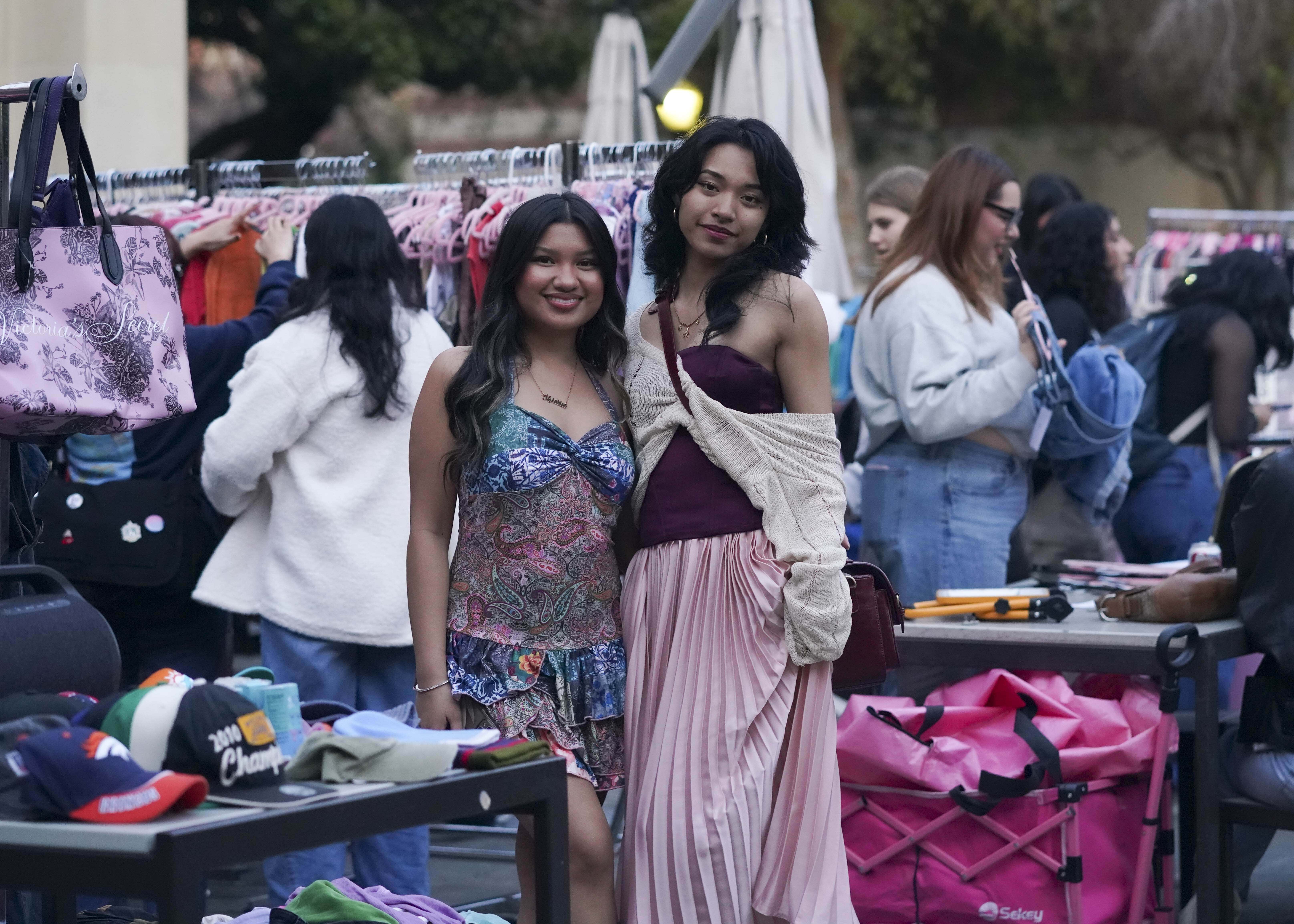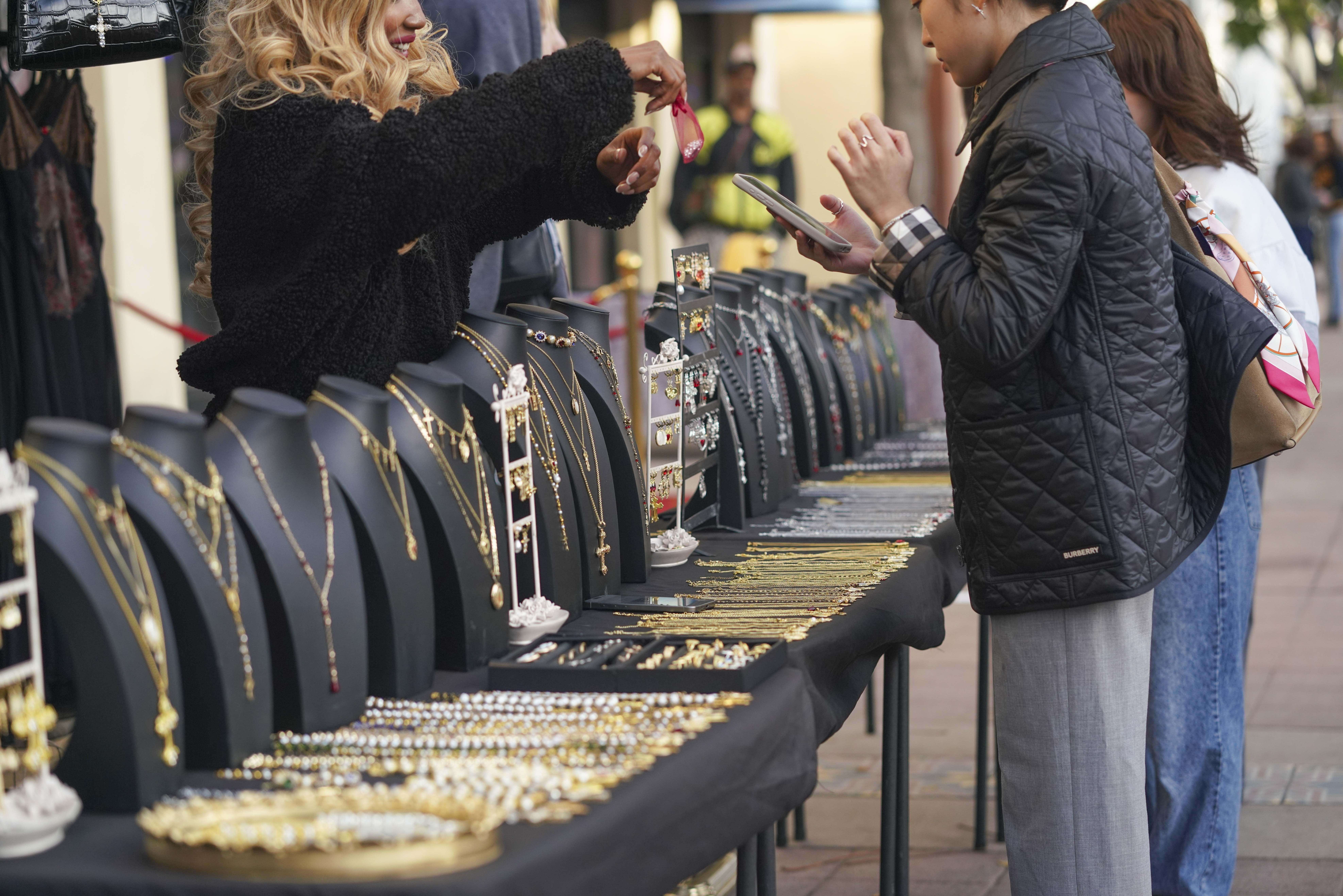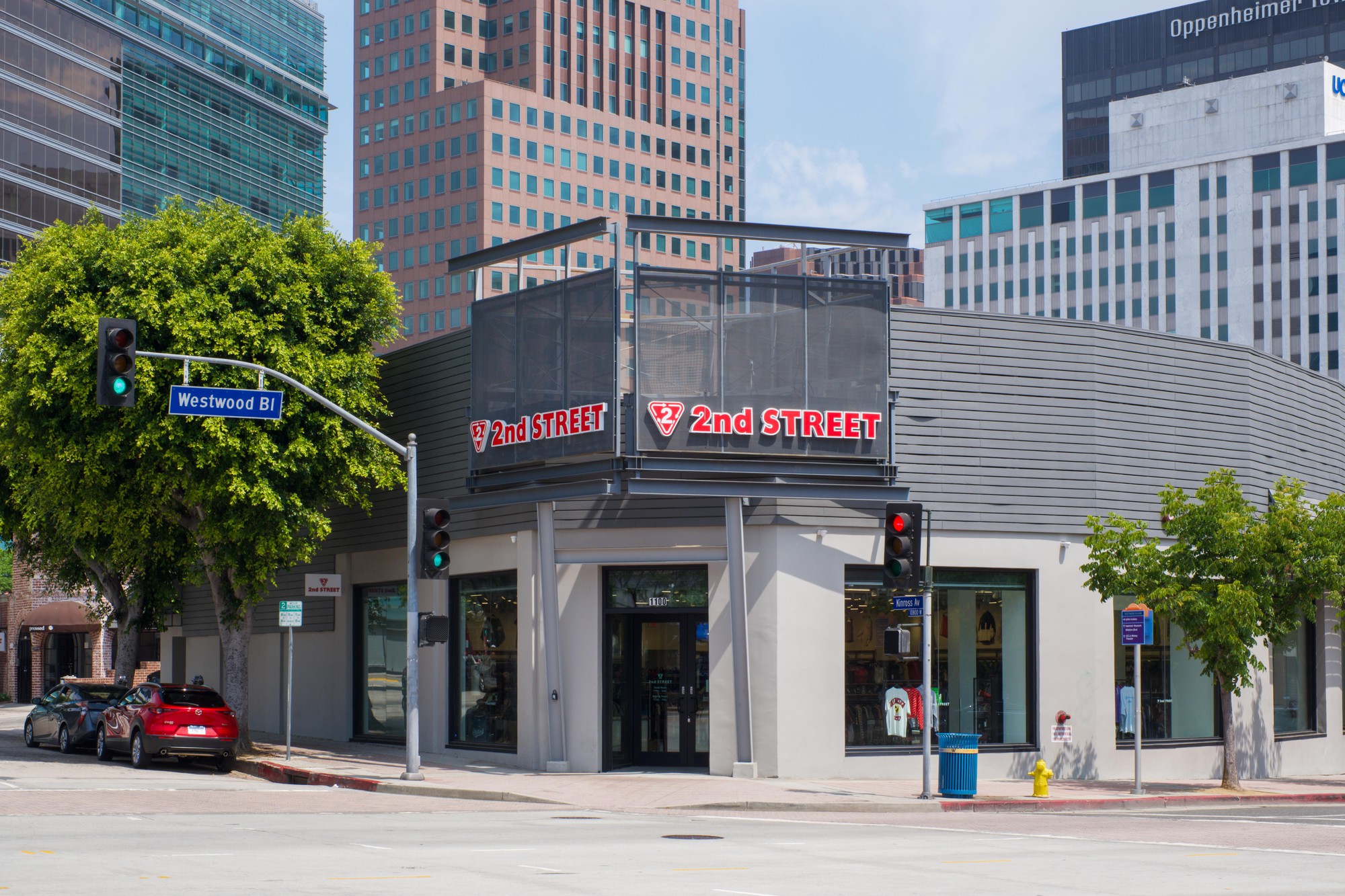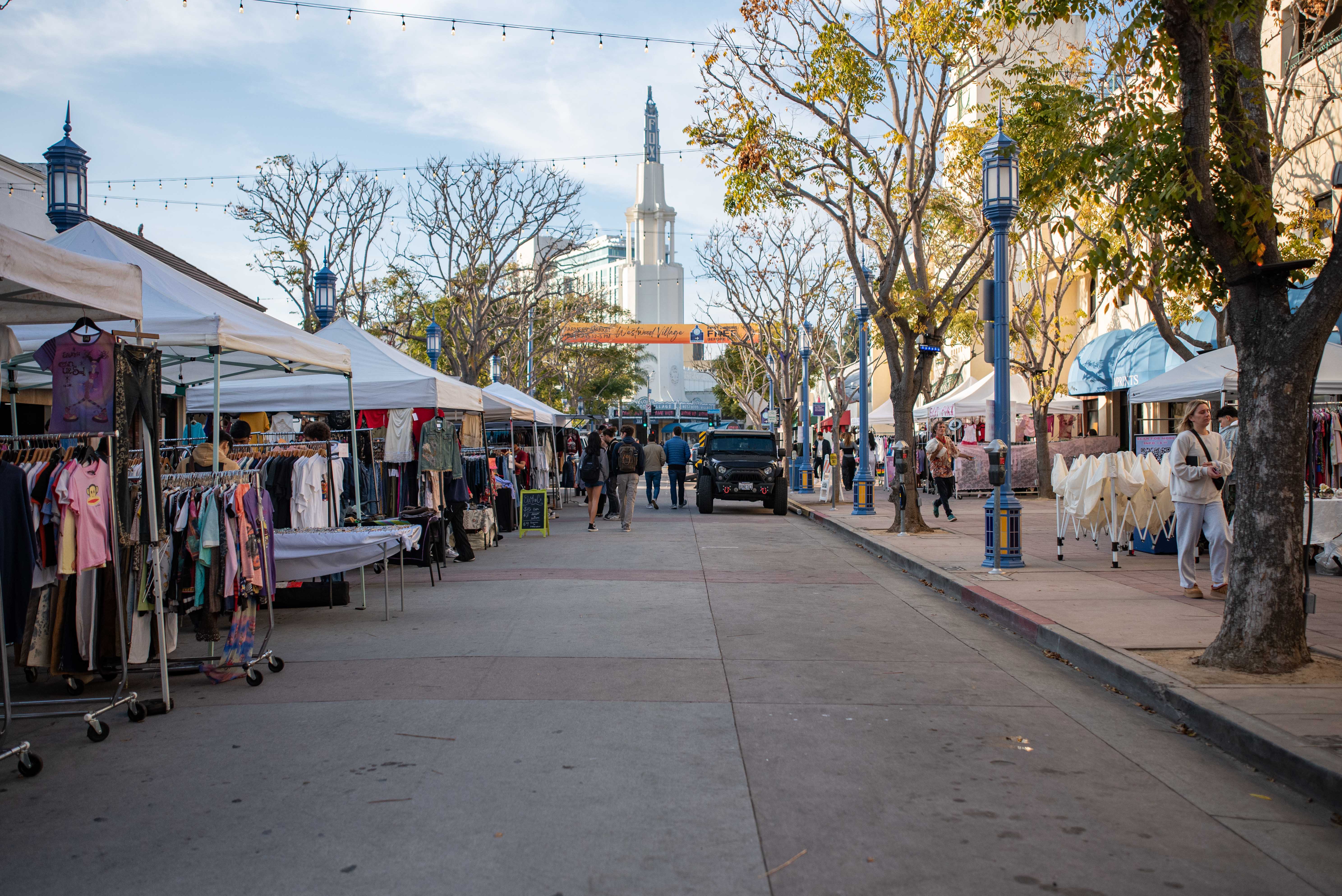A jewelry vendor shows some of the items on display to a customer at a flea market. (Vivian Le/Daily Bruin)
By Danielle Workman
March 15, 2025 at 9:51 p.m.
I am no longer allowed to buy jackets.
As a chronic shopper since I was 4 years old, my closet was stuffed with an endless supply of jackets, vests, belts and other pieces of clothing that still had tags on them. Waste was an important topic in my household, but growing up, I had only considered it in the context of clearing my plate – finishing every bite of food to avoid being wasteful. It never occurred to me that waste could also mean an overflowing closet, full of clothes I barely wore – consuming resources just to sit untouched. So when my mom instated my “no jackets” rule, I simply thought she wanted me to freeze at school.
Following my jacket ban, I tried slipping various sweatshirts, cardigans or any jacket alternative into shopping carts while out with my mom. Sensing my desperation for a loophole, she gave me one way out: The only jacket I could ever buy had to be thrifted. My mom thought she had me beat, knowing my distaste for secondhand shopping and its negative reputation at the time.
However, a TikTok video of a girl thrifting a “The Birds Work for the Bourgeoisie” sweatshirt, a 2019 trend I found absolutely hilarious, motivated me to trek to my local Savers. After hours of sifting through bins, I left the thrift store empty-handed and frustrated. When I complained to my mom, she just shrugged. She told me that once I found something I liked amid all the clothes I didn’t, I would love and appreciate it that much more.
At the time, I rolled my eyes. But later, as I stared at the untouched jackets in my closet – tags still dangling – I started to understand what she meant. Now, after years of rifling through racks and scouting for Pasadena’s best thrift stores, I have found unique clothes I will cherish forever – from a vintage Burberry coat I took on my senior trip to Italy to a checkered sweater I wore for my first day at UCLA.

Young people across the United States are becoming conscious of the waste in their closets and shopping habits. Generation Z has turned away from overconsumption, flooding “For You” pages with thrift hauls and warnings about the fast fashion industry. But thrifting isn’t just a phenomenon on social media. At UCLA, students, professors and organizations are using thrifting and secondhand fashion as tools to cultivate stronger, more connected communities built on shared values of creativity and sustainability.
Thrift culture’s popularity increased in response to fast fashion, a relatively recent development in American fashion consumption.
Felipe Caro, a professor of decisions, operations and technology management at the UCLA Anderson School of Management, explained that the fashion industry used to be based mostly on collections – seasonal groups of clothing and accessories based on a specific style or idea – lasting up to six months. The development of fast fashion producers such as Zara and H&M flipped the script, introducing new products in as quickly as a few weeks and aiming to capitalize on consumers’ desires for current trends, often at the expense of quality. The fad-based business model of fast fashion incentivizes frequent purchases, even if consumers don’t use or wear them – leading to closets full of unworn jackets, like my own.
Caro added that some companies, such as Shein or Temu, produce at rates exponentially faster than Zara and H&M with inferior quality, leading to much more waste overall than the seasonal model.
“I’ve heard of people that buy them, and if they don’t like them, they immediately throw them away,” Caro said. “They don’t even bother returning them because they’re so cheap.”
These issues of overconsumption in fashion are frequent topics of online discussion among youth today. Thrifting is one response that has gained traction and serves as a sustainable and mindful alternative to fast fashion.
Thrifting initially was primarily a practical choice driven by necessity in its early history, but it has always been centered around sustainability, said Sam Trezona, a fourth-year ecology, behavior and evolution student. Initially introduced to thrifting through social media, Trezona has since expanded their personal commitment to sustainability through fashion and style.
“Thrifting was my entry point into sustainable fashion, much like many people,” Trezona said. “I saw it on TikTok at some point and was like, ‘OK, I’m going to do this.’”
Lauren Kim, a second-year public affairs and sociology student, said she began to thrift after social media highlighted it as an eco-friendly way to score individual, one-of-a-kind pieces. Since coming to UCLA, she has become the journalism director of FAST at UCLA, which she said is the university’s first and largest fashion organization, and a member of RefineLA, a sustainable fashion club on campus.
“I try to thrift the vast majority of my clothes,” Kim said. “Nowadays, the majority of the new clothes that I am getting are secondhand, through some kind of source, whether that’s thrifting or vintage.”
Kim and Trezona credit social media for the boom of thrifting. They both identified thrifting content creators as a part of that surge in popularity, with influencers like Ashley Rous – also known as bestdressed – and Emma Chamberlain piquing the interest of them and their generation.
Influencer Alena Yuan, a fourth-year communication and economics student, is one of the creators contributing to the thrifting craze, promoting secondhand fashion in her videos. Since her first exposure in secondhand fashion from the hand-me-downs gifted to her by her mom, Yuan has thrifted since high school as a way to get clothes for cheap. Yuan began to collect her tips and tricks on building one’s style affordably and decided to make videos to share them with others.
She started her TikTok page this past summer, sharing content aimed at helping followers explore their fashion style and discover beauty products on a budget. Now surpassing 700,000 followers across social media platforms such as TikTok, Instagram and YouTube, Yuan has been able to reach her audience with the help of thrifting.
“Thrifting is a lot more mainstream now, so a lot more people go thrifting, even if they don’t necessarily need it,” Yuan said. “A lot of college students at UCLA are very sustainable, eco-friendly kind of people, so it also helps build a more sustainable community.”
Not only does thrifting help young people take on overconsumption and sustainability issues, but it also serves as a catalyst for community – from online spaces like Yuan’s to networks of fashion enthusiasts and buzzing flea market scenes.
Once a month in Westwood, locals can thrift at the Bruin Flea, an outdoor market bringing local businesses and brands together to support small vendors and build community. Luis Lopez, founder and creative director of the Bruin Flea, created this market on the front yard of a UCLA fraternity house in 2022 and is now hosting vendors all the way down at Broxton Avenue.
Lopez got his start in flea markets as a kid, helping his mom sell fragrances and makeup at their local swap meet. Eager to join in on the fun, Lopez started selling small toys – sparking a growing interest in sustainable entrepreneurship, he added. His focus soon turned to thrifting, be it clothes, furniture pieces or even a UCLA lamp he found and later gifted to a friend.
“Repurposing, rebuying, recycling, reusing clothing – all the ‘re-’s – that is 100% what you’re advocating for when you’re thrifting,” Lopez said.
Lopez hopes to use the Bruin Flea to help fashion-forward students and vendors create a community centered around sustainable, secondhand clothing.
For many vendors, that community is growing. Nestled among her dozens of racks and bins of vintage clothing, Laura Wences – a San Jose State University alumnus and owner of the secondhand fashion business With Laura Co – can be found selling at the Bruin Flea market. Inspired by a flea market booth selling handmade earrings, Wences initially started out in the sustainable fashion scene by making bucket hats by hand. At the Bruin Flea, she now sells vintage and upcycled clothing, such as a Free People-inspired jacket she made out of thrifted baby blankets.
“Now, I can give back to students who want sweaters, who need jackets, who need affordable clothing. Any offers I get (to sell at the Bruin Flea), I try to just say yes to,” Wences said.
Wences met Nicole Chrisney, a UCLA alumnus from the class of 2019 and owner of the fashion brand REBELFLOW, at a past Bruin Flea. Their friendship started when Wences offered to look after Chrisney’s booth as Chrisney was packing up. At the January Flea, Wences and Chrisney’s booths were positioned next to each other, allowing them to make small talk between sales.
“We’re all in this together, and we’re all one person,” Wences said. “I always tell all my vendor friends, ‘Look, markets don’t happen unless we’re there. It’s vendors, markets and then the customers. If it’s all strong and working well, it’s going to be a good market.’”
At its core, Lopez said the relationships between every participant at the market, be they customers or vendors, is what the Bruin Flea is all about.
“It’s about the vendors, and it’s about the people who get to go shop there and that interaction,” Lopez said. “It’s about the people who are coming to shop and connect and learn from one another.”
Other members of the Westwood thrift community are bringing similar attention to creating community through a shared love for fashion. Now the president of Unravel at UCLA – a fashion club centered on sustainability and social justice – Trezona leads club members through events ranging from smaller-scale thrift trips to larger-scale runways, exhibitions and community engagement workshops.
“Being around so many people who are so creative and so passionate about what they do is just really exciting,” Trezona said.

In preparing for their winter quarter exhibition, titled “Thrifting: A Critical History,” Unravel at UCLA and Trezona have prioritized highlighting thrifting’s deep relationship with sustainability and equity. Throughout the first week of March, Unravel at UCLA presented five different sections in its exhibition in Kerckhoff Art Gallery, taking viewers through the history of thrifting with various art installations.
The exhibition emphasized the origins of thrifting in minority and low-income communities and its current challenges due to rising prices and fast fashion, highlighting its history outside its current mainstream appeal.
“This art gallery about the history of thrifting is mainly a reflection,” Trezona said. “Everybody loves to thrift. You walk around campus, you talk to people about Unravel, they hear ‘sustainable fashion,’ and they immediately go, ‘Well, I love thrifting.’ And while that’s great, there is a part of thrifting culture that has become a trend.”
While thrifting has created hubs for community and sustainable efforts, it also raises a bigger question: Does it actually address the unsustainability of the fast fashion industry, or does it simply offer an alternative within the same cycle of consumption?
Students like Kim and Trezona wondered if the thrifting trend is really rooted in sustainable efforts. Trezona explained that while thrifting is a great practice, thrifting just to film a haul, score a deal and never wear the clothes you bought doesn’t solve the problem.
“This was always meant to be community-building, and I think focusing on that – and not focusing on, ‘What steals can I get?’, ‘How much can I get for how little?’ – that’s ultimately what we want to see shift,” Trezona said.
Kim added that individual habits affect thrifting’s overall impact on the fashion industry.
“I think sustainability is – at least among our generation – kept in mind a lot more. Whether or not that actually informs our choices, I think that depends on the individual more so than the industry as a whole,” Kim said. “In an ideal world, thrifting would be making every clothing brand in the world more green, but there’s definitely a spectrum of how much change is happening.”
Additionally, with the growing popularity of thrifting, those who thrift out of necessity are losing out on buying affordable clothes, with some thrift and vintage stores driving prices up with the increase in demand.
“It’s our job as UCLA students to be cognizant of the communities that we’re entering who rely on thrift stores for access to clothes,” Trezona added.
While it currently takes up less than 10% of the apparel market share, thrifting as a market is expected to continue growing, Caro said. He explained that this growth in thrifting will slow the issues caused by overconsumption, but efforts at the policy level must still be made to resolve them.
Although limited in scale, thrifting plays a meaningful role in reshaping consumption habits. Beyond just an alternative to fast fashion, it encourages a shift in mindset – one that values sustainability, appreciation for craftsmanship and the love behind each piece of clothing, Lopez said. By emphasizing intention over impulse, thrifting challenges a culture of waste and redefines the way Generation Z shops for clothes.
As thrifting continues to grow, Caro explained that thrifting is one practice that helps slow down the downsides of fast fashion, with other possibilities including renting or recycling one’s clothes.
Trezona reflected Caro’s sentiments, saying that upcycling can provide more benefits than thrifting when reducing waste. Trezona said they actively upcycle their clothing, frequenting the Pasadena-based arts and crafts thrift store Remainders Creative Reuse.
“It (thrifting) can’t be the end-all, be-all. It has to be the first step,” Trezona said.
Thrifting has become more than just a way to shop – it’s a way to rethink value, community and responsibility. While my jacket ban started as a restriction, it ended up shifting how I see clothing and consumption altogether.
Now, every thrifted piece of clothing isn’t just another addition to my closet – it’s a reminder that clothing carries stories. My mom’s war on jackets wasn’t just about buying secondhand or making me cold at school – it was about breaking the cycle of waste and choosing to be part of something bigger.


